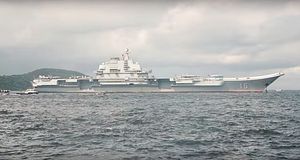The sole operational aircraft carrier of the People’s Liberation Army Navy (PLAN), the 60,000-ton Liaoning, a retrofitted Soviet-era Admiral Kuznetsov-class multirole aircraft carrier, entered Taiwan’s air defense identification zone (ADIZ) early on July 12, the Republic of China’s Military News Agency reports.
The Liaoning purportedly entered the ADIZ at 2:40 am and sailed north via the western side of the Taiwan Strait — China’s side of the strait. Taiwan’s Ministry of Defense said that it is monitoring the situation but that that there have been no “unusual developments” presently and that Taiwanese people should not be alarmed.
The PLAN aircraft carrier had been in Hong Kong from July 7 to 11 for events celebrating the 20th anniversary of the return of the city, a quasi-self-governing Special Administrative Region, to the People’s Republic of China. The ship was open to the public during its stay and thousands of locals visited the PLAN’s largest warship while it lay anchored in the city’s harbor.
The recent incursion into Taiwan’s ADIZ marks the fourth time that the PLAN’s aircraft carrier has sailed near the self-ruled island. For example, en route to Hong Kong, the Liaoning sailed south through the Taiwan Strait on July 2, prompting Taiwan to scramble fighter jets and warships to monitor the Chinese carrier strike group.
As my colleague Steve Stashwick pointed out about the July 2 transit, “the Chinese ships stayed on the mainland’s ‘side’ of the strait. If China had intended to send an unambiguous signal or provocation with the transit, then the ships could have easily sailed on the Taiwan ‘side’ to the east.” This also holds true for the July 12 passage.
The Liaoning carrier strike group consists of the Luyang III-class (Type 052D) guided-missile destroyer Yinchuan, Luyang II-class (Type 052C) guided-missile destroyer Jinan, Jiangkai II-class (Type 054A) guided-missile frigate Yantai, and one to two Yuan-class (Type 039A) or Song-class (Type 039) submarines.
As I explained in November 2016 (See: “Next Stop South China Sea? China’s 1st Aircraft Carrier ‘Ready for Combat’”):
The Liaoning can accommodate an air wing of 24 Shenyang J-15 multirole fighter jets, a variant of fourth-generation Sukhoi Su-33 twin-engines air superiority fighters, and up to ten rotary wing aircraft including Changshe Z-18, Ka-31, and Harbin Z-9 helicopters. (…) The carrier is fitted with an underpowered aircraft-launching system, a so-called ski-jump assisted Short Take-Off But Arrested Recovery (STOBAR) launch system, for fighter jets aboard the carrier.
In addition:
Given the STOBAR system, aircraft launched from the carrier will also have a more limited operational range due to the fact that they need to expend a considerable amount of fuel during take-off in comparison to aircraft launched with a catapult system as is the case in the U.S. Navy.
The aircraft carrier was commissioned in 2012 and primarily serves as a testbed for future Chinese naval aviation.

































